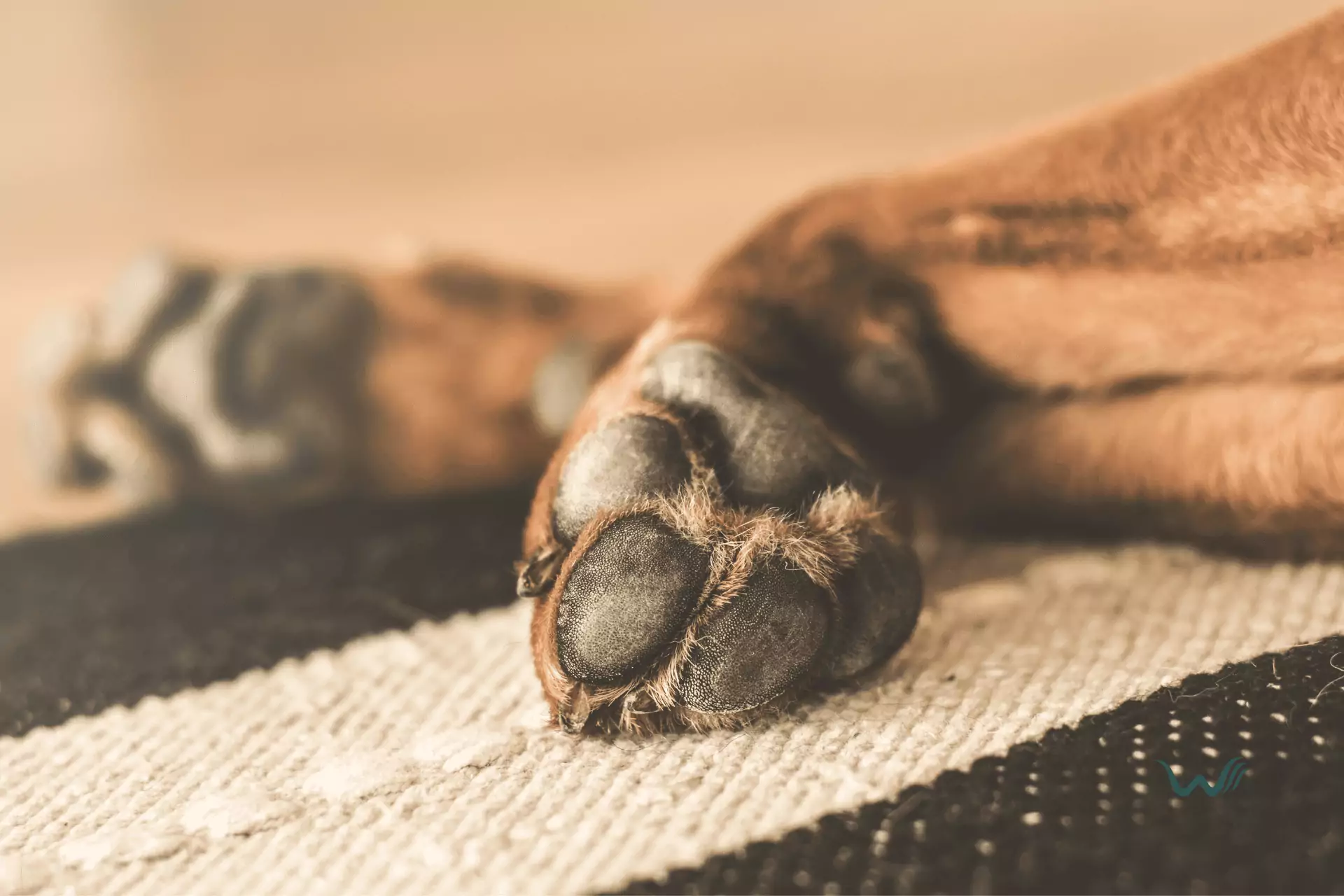

How Can I Treat Blisters On Dog And Cat Paws?
by Haley Mills
Last updated: January 30, 2024
Verified and Approved by:
Angela Morris,
MSW, LCSW
Fact Checked

Are you worried about your furry friend’s blisters on their paws? It can be distressing to see your dog or cat in discomfort, but fear not! In this article, we will guide you on effectively treating blisters on dog and cat paws. Blisters can occur for various reasons, including allergies, burns, or friction from rough surfaces. We will start by helping you identify the causes behind these blisters so that you can address the root problem.
Once you have identified the cause, cleaning and disinfect the blisters properly is essential. We will provide you with the necessary techniques to ensure that the affected area remains clean and infection-free. Additionally, pain relief and comfort are crucial for your pet’s well-being. We will discuss ways to alleviate their discomfort, whether it be through medication, topical treatments, or providing a cozy environment. Lastly, we will emphasize the importance of protecting the blisters from further irritation to aid healing. However, please keep in mind that if the blisters are severe or do not improve with home remedies, it is always best to consult a veterinarian for professional advice and treatment options.
Identifying the Causes of Blisters on Pet Paws
Now that you already know how blisters on dog and cat paws can be treated, let’s delve into understanding the various causes behind these painful blisters. Several factors can lead to blisters on pet paws. One common cause is friction. When dogs or cats walk or run on rough surfaces for extended periods of time, the constant rubbing and pressure can result in blisters. This is especially true if the surface is hot or abrasive.
Another cause of blisters on pet paws is burns. Dogs and cats can accidentally step on hot surfaces such as hot pavement or hot sand, which can cause their paw pads to burn and blister. Similarly, exposure to chemicals or irritants such as cleaning products or certain types of grass can also lead to blisters on their paws.
Additionally, allergies can play a role in developing blisters on pet paws. Some dogs and cats may be allergic to certain materials, such as certain types of grass or fabrics used in bedding. When they contact these allergens, their paws can become irritated and develop blisters.
It is important to identify the underlying cause of the blisters in order to provide appropriate treatment and prevent further discomfort for your pet.
Proper Cleaning and Disinfection Techniques
First, make sure to gently cleanse and disinfect the blisters on your furry friend’s paws. Begin by carefully washing the affected area with a mild, pet-safe soap and warm water. Be sure to use a soft cloth or sponge to avoid causing any further irritation. Gently pat the area dry with a clean towel, being careful not to rub or further aggravate the blisters. Once the area is clean and dry, you can apply a pet-safe disinfectant or antiseptic solution to help prevent infection. Follow the instructions on the product and apply it only to the affected area, avoiding any open wounds or broken skin.
After disinfecting the blisters, keeping your pet from licking or chewing at the area is crucial. This can be achieved by using an Elizabethan collar or a specialized pet bootie to cover the paws. These can be purchased at pet supply stores or obtained from your veterinarian. Additionally, it’s essential to keep your pet’s living environment clean and free from any potential irritants that could further worsen the blisters. Regularly sweep or vacuum the floors, remove any sharp objects or debris, and ensure that the bedding or resting areas are clean and comfortable. Following these proper cleaning and disinfection techniques can help promote healing and prevent further complications for your beloved furry friend.
Providing Pain Relief and Comfort
To help ease their discomfort, provide pain relief and comfort for your furry friends with blisters on their paws. One way to provide pain relief is by giving them over-the-counter pain medications specifically formulated for dogs and cats. However, it’s crucial to consult your veterinarian before administering any medication to ensure the correct dosage and rule out any potential contraindications. Additionally, you can try applying a cold compress to the affected area to reduce inflammation and soothe the blisters. Wrap a clean cloth or towel around an ice pack or a bag of frozen vegetables and gently press it against the blistered paws for a few minutes at a time, several times a day.
In addition to pain relief, creating a comfortable environment for your pets with blistered paws is essential. Provide them with soft bedding or blankets to rest on, which will help cushion their paws and alleviate pressure. Avoid rough or abrasive surfaces that can further irritate the blisters. You can also consider using protective booties or socks to cover the paws and prevent further damage. These can be especially helpful when your pets need to go outside or walk on rough surfaces. Lastly, make sure to give your furry friends plenty of love and attention during this time. Spending quality time with them, offering gentle massages, and speaking to them in soothing tones can help reduce their anxiety and provide emotional comfort.
Protecting the Blisters from Further Irritation
To protect the blisters from further irritation, you’ll need to keep your furry friend from licking or chewing on them. Licking or chewing can introduce bacteria and dirt to the blisters, leading to infection and slowing the healing process. One way to prevent your pet from licking or chewing on their blisters is to use an Elizabethan collar, also known as a cone or a cone of shame. This collar is placed around your pet’s neck and prevents them from reaching their paws with their mouth. It may take some time for your pet to adjust to wearing the collar, but it is an effective way to keep them from further irritating their blisters.
In addition to using an Elizabethan collar, you can also try using bitter sprays or ointments on the blisters. These sprays or ointments have a bitter taste that discourages pets from licking or chewing on the affected area. Before applying any product, consult with your veterinarian to ensure it is safe for your pet. Another option is to cover the blisters with a clean, breathable bandage. This can provide a physical barrier and prevent your pet from directly accessing the blisters. However, make sure to regularly check the bandage for any signs of irritation or moisture buildup, as this can also lead to further complications.
Can lice infestations in cats affect their paws and cause blisters?
Yes, lice infestations in cats can affect their paws and cause blisters. If left untreated, getting rid of cat lice becomes a priority to prevent further discomfort for your feline friend. It’s important to consult a veterinarian for proper treatment options to rid your cat of these pesky parasites.
Can the Same Treatment for Ear Mites in Puppies Be Used for Blisters on Dog and Cat Paws?
Treating ear mites in puppies may require different methods compared to healing blisters on dog and cat paws. The underlying causes of these conditions vary, necessitating specific treatments. Consulting a veterinarian is crucial to determine proper care and tailor treatment plans according to the specific needs of the puppy, dog, or cat.
Consulting a Veterinarian for Severe Cases
If the blisters on your pet’s paws are severe, it’s best to consult a veterinarian for proper treatment. A professional should evaluate blisters that are large, painful, or showing signs of infection. A veterinarian will be able to determine the underlying cause of the blisters and recommend appropriate treatment options. They may also provide pain relief medications or antibiotics to prevent further complications.
When you visit the veterinarian, be prepared to inform them about your pet’s symptoms and any recent changes in their environment or routine. The veterinarian may examine the blisters, take a sample for testing, or recommend additional diagnostic tests to identify the cause of the blisters. Once the cause is determined, they will develop a treatment plan tailored to your pet’s needs.
It’s important to remember that blisters on your pet’s paws can be a sign of a more serious underlying condition, such as allergies, autoimmune disorders, or infections. By consulting a veterinarian, you can ensure that your pet receives the appropriate care and treatment they need to heal properly and prevent future blisters.
Summary
Blisters on dog and cat paws can be a painful and uncomfortable for our furry friends. It is crucial to identify the causes of the blisters and take appropriate measures to treat and prevent them. Proper cleaning and disinfection techniques, along with providing pain relief and comfort, can help heal the blisters and prevent further irritation. Additionally, it is crucial to consult a veterinarian for severe cases, as they can provide professional guidance and recommend specific treatments or medications to aid in the healing process.
By being proactive and attentive to our pets’ paw health, we can ensure that they are free from discomfort and able to enjoy their daily activities. Regularly inspecting their paws for any signs of blisters or irritation, keeping their paws clean and dry, and providing them with suitable foot protection can go a long way in preventing the occurrence of blisters. Remember, our pets rely on us for their well-being, and taking the necessary steps to treat and prevent blisters on their paws is an essential part of responsible pet ownership.
Certify Your Emotional Support Animal Today

Why You Can Rely on Us?
At Wellness Wag, we believe your pet deserves care rooted in both science and compassion. Each article is carefully researched, written in clear language for pet owners, and then reviewed by qualified professionals to ensure the information is evidence-based, current, and practical for real-life care. Our goal is to help you feel confident in making informed decisions about your pet’s health and well-being.
Reviewed by
Angela Morris, MSW, LCSW
Angela is a licensed clinical social worker with 20 years of experience in patient advocacy and community mental health. She has assisted numerous clients with ESA evaluations and brings a deep understanding of disability accommodations, ensuring that all information is accurate, supportive, and practical.

Written by :
Haley Mills
Last Updated :
January 30, 2024











